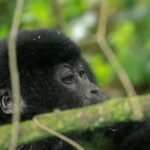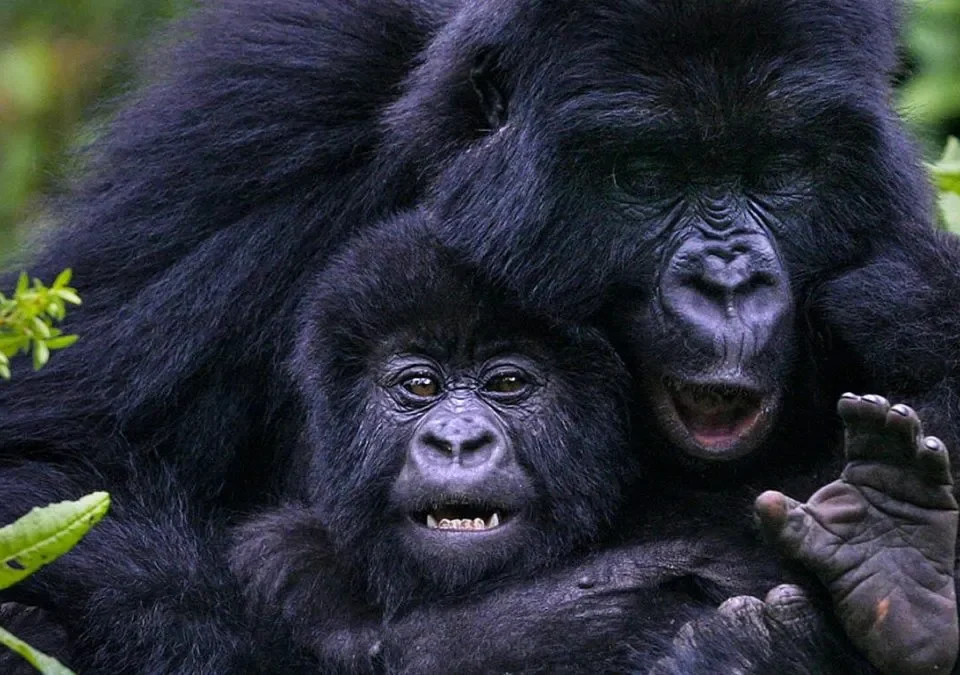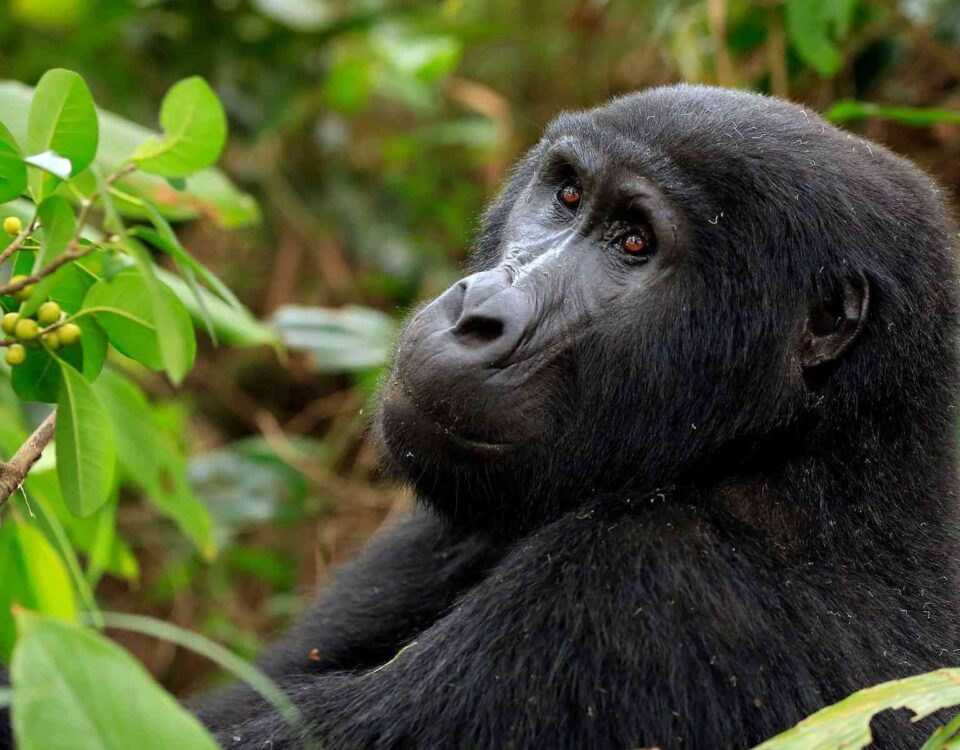
Where is the Best Place to Go Gorilla Trekking?
March 27, 2025
How Do I Book Gorilla Trekking?
March 28, 2025What Food Do Gorillas Eat?
Gorillas, the majestic primates of the African wilderness, are among the closest relatives to humans in the animal kingdom. These intelligent creatures are herbivores with a diverse and selective diet that is crucial to their survival and well-being. At Wild Village Safaris, we are passionate about wildlife conservation and educating travelers about these incredible animals. Understanding what gorillas eat is essential not only for their preservation but also for fostering a deeper connection with nature. In this article, we explore the food preferences, dietary habits, and feeding behaviors of gorillas in detail.
The Herbivorous Nature of Gorillas
Gorillas are primarily herbivores, meaning they rely on plant-based food sources to meet their nutritional needs. While their strong and muscular physiques may suggest a carnivorous diet, gorillas do not hunt other animals. Instead, they consume a wide range of vegetation, which varies depending on the species, the environment, and the availability of resources.
There are two main species of gorillas: the Western gorilla and the Eastern gorilla, each of which has specific dietary preferences based on their habitats. Despite these slight differences, both species share a largely herbivorous diet that includes a variety of plant-based foods such as leaves, fruits, stems, flowers, and bark.
Key Components of a Gorilla’s Diet
Gorillas are highly selective feeders, choosing specific types of plants depending on their nutritional value, taste, and availability. Their diet is rich in fiber, vitamins, and minerals, which are essential for their overall health, muscle development, and energy levels. Below are the primary food groups that form a gorilla’s diet.
Fruits
Fruits are an important part of a gorilla’s diet, particularly during the fruiting seasons when they are abundant. Gorillas enjoy a variety of fruits, including bananas, papayas, berries, and figs. These fruits provide high levels of sugar, which serve as a key energy source for gorillas, particularly given their large size and active lifestyle. The sweet, juicy flesh of fruits also helps with hydration, as they often contain high water content.
However, gorillas are quite discerning when it comes to fruit. They typically choose ripe, sweet fruits and avoid those that are unripe or sour. The availability of fruit can vary depending on the region and the season, so gorillas will adjust their diet accordingly.
Leaves and Stems
A substantial portion of a gorilla’s diet consists of leaves, which are readily available in their environment. Gorillas are particularly fond of young, tender leaves from a variety of plants, trees, and shrubs. These leaves provide essential vitamins, minerals, and fiber, helping to keep the gorilla’s digestive system healthy.
Stems are also a significant part of their diet. They often consume the stems of plants such as bamboo, wild celery, and other vegetation. These fibrous plant parts offer additional nutrients and play a critical role in maintaining digestive health by providing bulk and aiding in the breakdown of food.
Bark and Roots
During certain seasons, when fruits and leaves become scarce, gorillas will turn to the bark of trees and roots to satisfy their hunger. Bark is a tough, fibrous material that gorillas can easily chew through with their strong jaws and molars. It provides essential minerals and fiber, which support the gorilla’s overall health.
Roots, particularly those of wild plants like wild ginger, are another important food source for gorillas. These underground parts of plants are rich in carbohydrates and other nutrients that help gorillas maintain their energy levels, especially during periods when other food sources are less abundant.
Flowers
Gorillas also eat flowers, although this forms a smaller part of their diet. Flowers are rich in vitamins, calcium, and other essential nutrients, contributing to gorillas’ overall nutritional intake. Some flower species also contain proteins that support the gorilla’s muscle health. Gorillas tend to consume flowers when they are in season and available in their habitat.
Insects
Although gorillas are mainly herbivores, they occasionally consume insects, particularly ants and termites. These insects provide a rare but valuable source of protein and essential minerals. Insects make up a very small portion of a gorilla’s diet, and gorillas generally forage for them by breaking open ant nests or termite mounds with their hands and teeth. This behavior shows the adaptability of gorillas in utilizing whatever food resources are available.
Feeding Behavior and Daily Foraging
Gorillas spend a significant portion of their day foraging for food. Their diet is influenced by the availability of different plant species in their environment, and their feeding habits are often shaped by the season. During the wet season, when fruits and young leaves are plentiful, gorillas will focus on these high-energy foods. In contrast, during the dry season, when plant resources are less abundant, gorillas may switch to more fibrous plants such as bamboo and bark.
Gorillas are known for their slow and deliberate eating habits. They use their strong jaws and teeth to tear through leaves, stems, and bark, taking their time to chew and digest their food thoroughly. In some cases, they may spend several hours each day foraging, particularly when food sources are scattered and not easily accessible.
Social Feeding and Group Dynamics
Gorillas are social animals, and their feeding behavior often involves the whole group. The dominant male, known as the silverback, typically leads the group in the search for food, guiding them to the best areas for foraging. Although silverbacks have a dominant role, they do not monopolize food. Instead, they ensure that all members of the group, including the younger gorillas and females, have access to sufficient resources.
Gorillas often forage together, creating a sense of social bonding within the group. While they may not directly share food, their proximity to one another while eating strengthens the social cohesion of the group. Feeding together also provides a sense of security, as the presence of multiple individuals helps protect the group from potential threats in their environment.
The Importance of a Balanced Diet
A balanced and varied diet is critical for the health and well-being of gorillas. Their digestive systems are specifically adapted to handle tough, fibrous plant matter. Their large stomachs help break down cellulose from plants, and their complex digestive systems allow them to extract maximum nutrients from the food they consume. Gorillas must consume large quantities of food—often up to 30-40 kilograms (66-88 pounds) per day—due to the low caloric density of their plant-based diet.
Additionally, their digestive system works slowly, allowing for thorough extraction of nutrients. This slow digestion, however, means that gorillas must spend a considerable amount of time foraging and eating to meet their energy needs.
Conservation and Habitat Protection
Understanding what gorillas eat is crucial for their conservation. Habitat destruction, deforestation, and poaching are significant threats to gorillas’ food sources and survival. As their natural habitats become fragmented or destroyed, gorillas may face challenges in finding sufficient food to sustain themselves. Protecting these ecosystems and ensuring sustainable practices are essential for the survival of gorillas.
At Wild Village Safaris, we advocate for responsible tourism and support conservation initiatives that aim to preserve the habitats of gorillas. By protecting their food sources and natural environments, we can help ensure that gorillas continue to thrive in the wild for generations to come.
Conclusion
Gorillas are fascinating creatures with complex feeding habits. Their diet consists mainly of plant-based foods such as fruits, leaves, stems, bark, roots, and flowers, with occasional consumption of insects. These dietary preferences are essential for their survival, providing them with the necessary nutrients and energy to maintain their large, muscular bodies. By understanding the foods gorillas eat and their unique feeding behavior, we can better appreciate their role in the ecosystem and contribute to their ongoing conservation. At Wild Village Safaris, we are dedicated to protecting these incredible animals and their habitats through responsible tourism and conservation efforts.




